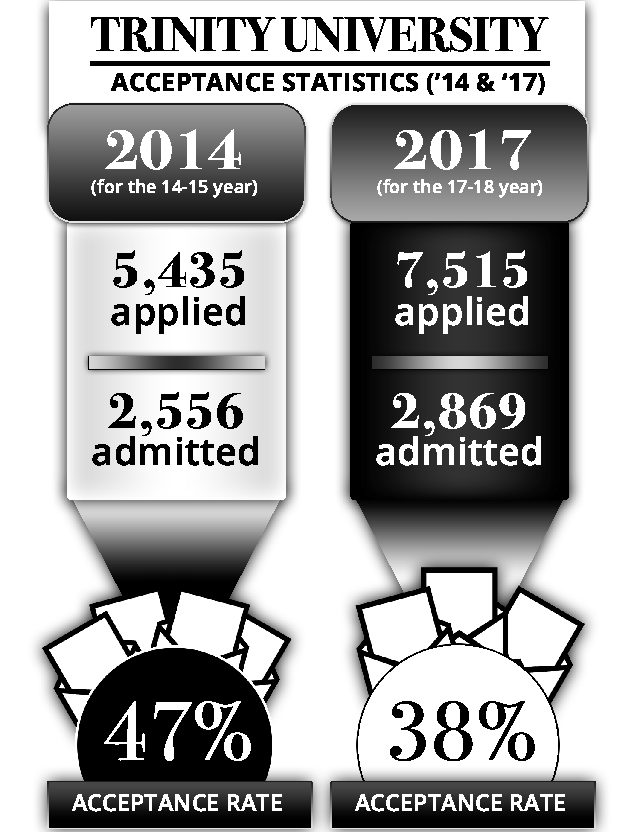Last Thursday, Trinity University president Danny Anderson presented the annual budget briefing to faculty and staff in Stieren Theater. He addressed tuition increases, annual revenues, the potential acquisition of the Oblate property west of campus and updates to the Trinity master plan.
Trinity traditionally maintains a conservative budget, aiming to minimize deferred maintenance and saving a budget contingency equal to four percent of total revenues in order to account for unexpected expenses. Balancing the university’s budget depends on admissions as well as annual donations and giving campaigns.
7,515 students applied to Trinity University this year, compared to the 5,435 applicants for the 2014–2015 academic year; 2,869 were admitted this year, compared to the 2,556 of 2014–2015. The university’s acceptance rate has subsequently dropped from 47 percent to 38.2 percent.
Anderson reports that the pool of students accepted this year have higher grade point averages and test scores than students accepted just two years ago. This means the university has to work harder to yield a higher percentage of students admitted, as those students likely have the opportunity to choose from a range of high-quality universities to attend. Admissions officials hope to bring in between 620 and 660 students, about 10 students for every faculty member.
Trinity’s endowment faces some sustainability concerns. Ideally, the university would see returns to the endowment at 7.5 percent or higher. But this year will see returns of only 2.7 percent, while similar universities receive a median of 2.9 percent.
“We want to spend 4.5 percent out of our endowment every year and we want it to grow at least at a rate of inflation [about 2.7 percent],” Anderson said. “That would be a number where you could say there is real stress.” The national median for endowment growth is a meager 2.1 percent.
Further, expenses have increased to 4.8 percent, significantly higher than the planning threshold of 2 percent. The median for Trinity’s peer institutions was also 4.8 percent.
“Everybody else is struggling with this,” Anderson said.
One major expense was a large, unavoidable increase in medical insurance costs. This price hike caused the merit pool goal to move from the 3 percent of the last few years to 2 percent. The merit pool is the amount of money allocated for increases in employee salaries. Completion of the goal is contingent on meeting the aforementioned enrollment and tuition targets.
The City Vista acquisition was likely another source of expense, though numbers were not offered during the presentation.
Anderson noted that the university is looking into ways to reduce this stress, for instance by hiring a staff attorney to reduce legal fees. The university is committing to focus on net tuition revenue growth, improve fundraising and manage expense growth. Admissions are to go a long way toward accomplishing these goals.
“Everything we’re doing in admissions shows that we’re getting more applicants, we’re getting higher quality applicants, we’re becoming more selective,” Anderson said. “It’s just a slow process to get to that point where more people say, ‘I don’t need as big of a merit aid to make me accept the decision to go to Trinity.'”
Admissions numbers aren’t the whole picture; Anderson explained that the tuition rate is being increased by 4.5 percent, while room and board rates will see a 3 percent increase. This puts tuition at $40,728, up from the current $38,974.
Meal plans will see higher prices, too. The 200-swipe plan will be $4,004, the 240-swipe plan will be $4,303, while the junior-senior “Flex” plan will run students $3,859. These rates do not include an 8.25 percent sales tax.
Anderson identified areas for campus improvement over the next year, including renovations for Myrtle McFarlin, Harold D. Herndon Hall and Albert Herff-Beze hall as well as new elevators in Bruce Thomas Hall. $1.1 million will be spent on campus network and Wi-Fi improvements, upgraded on-campus signage will be instituted and renovations for several Oakmont houses will take place as well.
Looking further into the future, Anderson updated attendees on the campus master plan. Designs are being drafted for a new campus “front door” entrance on Hildebrand to the north of campus, and there are plans to repurpose Coates University Center as the main dining facility on campus. Anderson suggested removing parking areas on the south of campus near McLean and converting them into green space to create new social spaces and facilitate water runoff.
The University is considering purchasing the 9.4-acre Oblate property to the west of campus, as well. When Anderson opened the floor to questions, they were about the Oblate purchase.
Paul Myers, professor of computer science, noted that it could add parking to campus, but asked how the university plans to parking stress in central campus.
“As we’re looking at the creation of self-driving cars, as we’re looking at students who come to college renting ZipCars, and not necessarily coming with an identity linked to a car the way mine was when I was 17 years old, then maybe we do not need to be building as many parking spots for the future,” Anderson said. “Are we really going to need that many parking spaces five years from now? All the consultants that we work with say that [this] is the way to be thinking.”
Anderson closed by explaining that the Oblate acquisition will likely close by the middle of April, provided that environmental certifications clear within the next few weeks.
“It is really important for us as a community to understand all the little bits and pieces of the strategy that we’re using to try and move forward,” Anderson said. “You each play a part in making all of those different pieces work and I thank you because we could not achieve our goals if it were not for all of you working together.”







